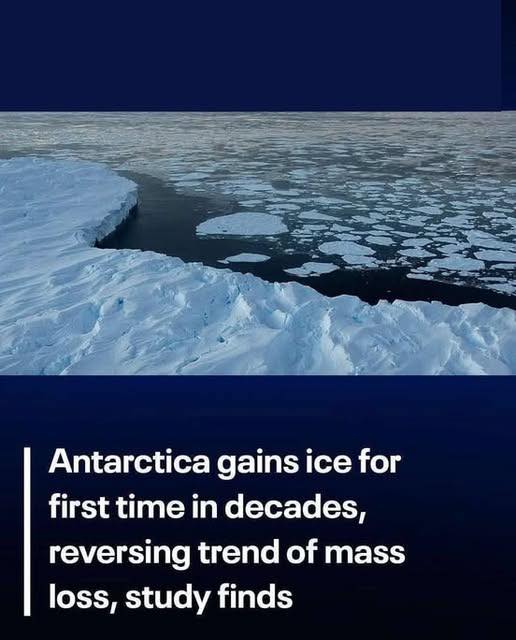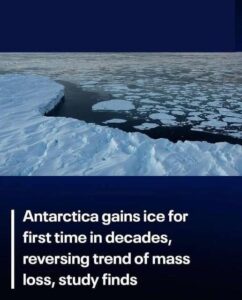Antarctica sees first ice gain in decades

The Antarctic Ice Sheet (AIS), a major contributor to global sea-level rise, has been steadily losing mass, especially in West and parts of East Antarctica. However, between 2021 and 2023, it gained around 107.79 gigatonnes of ice annually—an unexpected shift after nearly two decades of decline.
Researchers attribute this anomaly to unusually heavy snowfall, which temporarily reduced the annual sea-level rise by 0.30 millimeters. This change was detected using satellite gravimetry data from the GRACE and GRACE-FO missions, which track Earth’s gravity to monitor ice mass.

Despite the gain, scientists warn that this is not a sign of long-term recovery. The gain was driven by abnormal weather, and continued snowfall and cooler temperatures are unlikely under current climate trends.
Rising temperatures and warming oceans remain the main threats, reducing snowfall and accelerating ice melt—key drivers of sea-level rise. The climate crisis continues to pose serious risks to Antarctica’s stability.
Ice Gain in Antarctica? Cool Story, Still a Hot Planet
Antarctica gained ice – so naturally, climate change must be canceled. Pack it up, scientists! At least, that’s the impression you might get from some recent headlines and viral posts. But what’s really going on? Were decades of climate science just an overreaction?
Both the social media comparisons and the misinterpretation of the new study overlook the big picture: short-term changes and cherry-picked data don’t overturn decades of global patterns. It’s like pointing to a cold day in Spring and declaring winter is back, while ignoring both the warm temperatures the week before and the forecast for sunshine the following week.

Antarctica’s Ice, Ice Baby
Antarctica is a massive continent is covered by an ice sheet that averages about 1 mile (1.6 kilometers) thick. This ice sheet contains 60% of the Earth’s freshwater, making it one of the most critical factors in determining future sea level rise. Unlike sea ice, which floats on the ocean’s surface, the Antarctic Ice Sheet is grounded on land, so when it melts or breaks off into the sea, it directly contributes to rising sea levels. To measure the mass of this enormous ice sheet, scientists use satellite missions like NASA’s GRACE and GRACE-FO.
Climate Change Cancelled? Not Quite – Just a Snowy Intermission
A recent study in Science China Earth Sciences found that between 2021 and 2023, the Antarctic Ice Sheet gained an average of 108 gigatons of ice per year, largely due to unusually high precipitation in East Antarctica. This snowfall was concentrated in four key glacier basins that had previously shown signs of instability. This event briefly offset global sea level rise by about 0.3 millimeters per year.
Both the scientists behind the study and others who reviewed it emphasized that this was not evidence of a long-term reversal. Rather, it was an anomalous weather event, likely linked to shifts in winds and atmospheric moisture patterns – both of which may be influenced by climate change itself. Warmer air holds more moisture, so as global temperatures rise, more moisture becomes available for precipitation in colder regions like Antarctica. In this way, climate change can actually increase snowfall in certain parts of Antarctica.
So yes – Antarctica gained ice recently, but this rare weather-driven event is actually another symptom of a changing climate, not a sign that everything is fine.
One Icy Plotline Doesn’t Melt the Whole Climate Story
Zooming out, the long-term data show a much more troubling pattern. Between 2002 and 2023, Antarctica has experienced a net loss of approximately 1.85 trillion tons of ice. Moreover, the ice loss rate nearly doubled from the first decade of the 2000s to the second. The majority of this loss comes from West Antarctica and parts of East Antarctica where warm ocean waters are accelerating glacier flow and melting ice shelves from below. In contrast to short-term snowfall-driven gains like the one described in the paper, these long-term changes reflect a more permanent shift in the continent’s stability.

Cherry-picking Christmas: Why Two Dates Don’t Make a Trend
The viral side-by-side sea ice images on social media pick two arbitrary dates, December 24 in 1979 and 2024, and claim that sea ice has grown 17%. But that’s like judging a sports team’s entire season based on the score at halftime in two different games, decades apart. It says nothing about the full season record, win/loss trends, or how the team has been performing overall.
Scientists have pushed back on this, noting that Antarctic sea ice is influenced by complex interactions between winds, ocean currents, and seasonal weather. Long-term data from the National Snow and Ice Data Center (NSIDC) show that sea ice extent increased slightly from 1979 to 2015, then declined sharply in subsequent years, with record lows in 2023.
Cold Facts, Hot Planet: One Cool Year Isn’t a Climate Reboot
The recent short-term gain in Antarctic ice mass and misleading sea ice comparisons on social media have been used to sow doubt about climate change. But the full scientific context tells a different story.
Yes, Antarctica gained ice between 2021 and 2023. This was due to unusual precipitation driven in part by climate change itself. The long-term trend remains one of accelerating ice loss, with grave implications for sea level rise.
Climate change is not disproven by a few years of snowfall. Just like one rainy day doesn’t mean drought is over, one snowy season in Antarctica doesn’t mean the planet isn’t warming.

